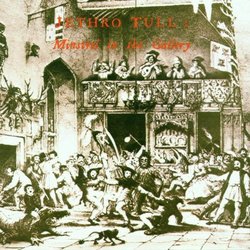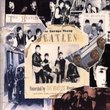| All Artists: Jethro Tull Title: Minstrel in the Gallery Members Wishing: 7 Total Copies: 0 Label: Capitol Original Release Date: 1/1/1975 Re-Release Date: 9/12/2000 Album Type: Original recording reissued Genres: Pop, Rock, Classic Rock, Metal Styles: Progressive, Progressive Rock, Album-Oriented Rock (AOR) Number of Discs: 1 SwapaCD Credits: 1 UPCs: 094632108227, 094632108241, 2605000013494, 762185169346, 766482094943 |
Search - Jethro Tull :: Minstrel in the Gallery
 | Jethro Tull Minstrel in the Gallery Genres: Pop, Rock, Classic Rock, Metal
|
Larger Image |
CD DetailsSimilarly Requested CDs
|
CD ReviewsCouldn't Ask For A Better One Bellagio | Las Vegas | 09/14/2000 (5 out of 5 stars) "An album which is a favorite of hard-core Tull fans. It is an album that is very unique in the Tull catalogue, practically without exception the music on Minstrel would not fit well on any other Tull album. The most apt descriptions are simple, hard hitting adjectives: Raw, acerbic, harsh, grating, crass, self-absorbed -- even self-obsessed. The emotions run wild and uncontrolled, a gamut encompassing guilt, anger, cynicism, bitterness, self-deprecation, and lust all the way to sadness, humor, altruism, and at last, optimism. The end result is utterly magnificent.Mr. Anderson has been quoted as saying that he thought Minstrel was "too autobiographical," expressing a feeling that this was damaging to the album. For many long-time Tull fans it is precisely this feature that is so attractive. For those not amongst the hard-core of fans, if you like power in your music, there is more than enough here to satisfy the most testosterone-laden circulatory system. But be prepared for a great deal of subtlety as well, as most of the works here appear to be written in a manic-depressive style, yielding rapid-fire insights into the many conflicts raging within the artist at what appears to be a difficult time in his life.The title track starts out simply and accoustically, as everything on this album does. But as is also commonplace here, it quickly moves to a faster pace and a harsher demeanor. (Pay a little attention to the extra percussion effects early on, for the semi-joke at the end of Baker St. Muse relies on them). Early on, Martin Barre takes complete control of the massive opening track with his seering guitar, never really relinquishing the song. The overpowering sensation that one takes away from this album is of Mr. Barre's strident guitar, and that begins right here in the autobiographical title track in which Mr. Anderson throws out humourous rapid-fire snippets of lyric alluding directly to earlier Tull songs (for example, "overfed" -- Fat Man -- "and undertakers" -- Two Fingers).Two stunning, standout tracks, Cold Wind to Valhalla and Black Satin Dancer follow. These appear to be the two least openly autobiographical works in the set. The lovely opening acoustic theme in Cold Wind is reprised an album later as the seed for the lovely Salamander. Here the acoustic theme quickly develops into another powerful and very up-tempo performance highlighted, again, by Mr. Barre's ever-present and ever-boisterous guitar. Cold Wind rightfully remains an important part of Tull's live repertoire to this day. Black Satin Dancer is a much more melodic descendent of the previous album's Back Door Angels. The developing style presented here would soon lead to other Tull classics like No Lullaby, Flying Dutchman and Seal Driver, and eventually bear full fruit in Farm On The Freeway many years later. However, of all these, Black Satin Dancer is blessed with perhaps most melodic main theme, although the actual development of that theme is somewhat more ragged than would occur in the later works. David Palmer's orchestral arrangements, John Evans' opening piano work and, especially, Jeffrey Hammonds' simple but beautiful bass are prominent in this landmark song.Two all-acoustic tracks, Requiem and One White Duck/0¹° = Nothing At All, very different in emotion and effect, bridge the center of the album. The very slow and quiet Requiem, as slow in tempo as any song in the Tull catalogue, appears to the be sad story of the breakup in Mr. Anderson's first marriage -- a breakup apparently due to the long absences of Mr. Anderson, which are so much a part of his chosen profession. A heavy burden of guilt is prominent in the lyric and redolent in the music. This all appears to have left deep scars in his psyche -- many classics of Tull's later works, Black Sunday among a number of others, appear to have their genesis in this damaging experience. One White Duck presents very different emotions. While the opening portion is one of those stunning ballads which we've come to expect from Tull, imbued with murky yet obviously personal lyrics -- perhaps related in some way to the previous song -- the latter portion is laced with bitterness and anger at critics. Mr. Anderson's ongoing battle with certain critics at this time is a little unbecoming in his music, and fortunately he leaves it, for good, here.The huge Baker St. Muse medley takes us, essentially, to the end of the album. Constructed like a sandwich -- the title number comes in at the top and bottom, with four individual sections occupying the middle -- this masterful conglomeration bares the author's soul, serious warts and all. The rapid, staccato presentation of Pig-Me and the Whore is a perfect match for the blatantly crude lyric, which shows us a, umm, less-balanced side of the artist. Nice Little Tune is just that -- a little musical Prozac after the disturbance which preceeded it. Crash-barrier Waltzer is a miniature ballad about a female form of the Aqualung character -- though somewhat less lecherous than our old friend. The author plays the role of hero here, perhaps with just a touch of self-parody. The melodic and compelling Mother England Reverie breaks us from the darker regions of the author's psyche into the highlands of self-assured optimism. To me, it is the highest point not only of the medley but perhaps of the entire album. It is the summation of the often dark tour through the author's mind, and an eminently satisfying one at that.The optimistic finish of the medley renders the little ending skit "I Can't Get Out" as a semi-serious joke -- as opposed to a cry for help. This is topped off nicely by the brief Grace in which the musician finds life not so bad at all: greeting the sunny morning with lady in his bed and plenty of money for breakfast!" Jethro Tull Rocks Lonnie E. Holder | Columbus, Indiana, United States | 07/27/2002 (5 out of 5 stars) "After "Aqualung" and "War Child" were such huge successes, I was worried that Jethro Tull had, as Frank Zappa phrased it, gone commercial. "Minstrel in the Gallery" corrected that notion. "Minstrel in the Gallery" returns Tull to their original self-defined genre.I always get a kick out of people trying to fit Jethro Tull into any particular type of music, because they are just plain not anything. While they have elements of hard rock/metal, elements of pop, elements of progressive, elements of folk, elements of rennaisance, and even a bit of classical here and there, they are all of the above and none of the above. They just are.The opening track, "Minstrel in the Gallery", begins with hammering and noises that make it sound as though the group is on a stage that is being prepared for a play. The song then transitions into a bard-like minstrel song, and then takes off into a hard rock song. An excellent opening song that sets you up for the things to come."Cold Wind to Valhalla" won't fool you. There are some violins and flavor of folk/rennaisance, but at around 1 minute and 45 seconds into the song it switches into overdrive and you realize you are listening to a solidly rock song. Excellent use of violins in this song to help the orchestration. Hard to believe that violins can be a hard-rock instrument.You hear classic Jethro Tull in the beginning of "Black Satin Dancer", then some hard rock riffs, and you suspect what will come next in this song. And you would be right and wrong. This song is a sensual song with allusions of sexual foreplay and intense longing, perhaps even lust. Sometimes I felt some occasional elements of King Crimson, and then not. The hard rock elements intertwine with classic Tull and some occasional progressive flashes. A most excellent song.Then you are lulled by the melancholy strains of "Requiem", as Ian Anderson and company sound more like Kansas or Simon and Garfunkel, and yet, the sound is still Tull. This song is meant to be listened to for the feel, and not for the words.Then, as you move into "One White Duck/0^10 = Nothing at All" you realize that "Requiem" was a perfect transition between "Black Satin Dancer" and this song. I love this song, because it seems to have meaning, and seems to have no meaning, and you hover on the edge of understanding without understanding, though you think you should, and could, if you could listen a little longer and read the lyrics just one more time. But this song is, of course, classic Tull, and the lyrics do mean something, but they are art, and art is for the interpretation of the listener. Don't make too much of this song, and don't make too little. Just listen and love it.Then, off to signature Tull, the extended, intertwined story-song, "Baker St. Muse". Here you have an intro about a muse, a very down-to-earth fellow crying out that Jethro Tull wasn't the commercial group that "War Child" seemed to make them out to be. We are in the gutter like we always were, singing about the things that haven't changed, and so on to the next part of our story...The other songs are stories of the street, likely stories of the Baker St. Muse (aka Jethro Tull). These songs are very sexual. Today they might even get a warning label, even though there is no use of the crude words which seem so popular. There is no need, the point is well made without resorting to a limited, non-descriptive vocabulary. This group of songs finish with "Mother England Reverie", which is a protestation that the singer is just a street player, a muse, and he'll never be anything but.The CD finishes with a wrap-up song, "Grace", which is a marvelous little epilogue that not only finishes the CD, but also asks a simple, but layered question, "Hello breakfast. May I buy you again tomorrow?" In the context of the CD the question more likely means, can we be here tomorrow, can we still do what we are doing? And perhaps, in consideration of the other songs, will anyone care.Sometimes I think of the songs, coming after the nearly-pop success of "Warchild", as being an apology for straying from the princples of Jethro Tull's music and style. Perhaps I'm wrong. Perhaps not. Regardless, listening to the seven albums before Warchild, and then "Warchild", and then "Minstrel in the Gallery", you realize that "Warchild" was not Tull's usual music, and "Minstrel in the Gallery" put them squarely back where they once were.Jethro Tull has never been everyman's group. Never will. They occupy a unique place in modern music that will likely never be defined. This CD is solidly at the heart of the kind of music Jethro Tull is known for making. It is among the best of Jethro Tull." A collaboration of talent at its finest! Fuamoni | Michigan | 09/13/2000 (5 out of 5 stars) "Jethro Tull is a band with many talented musicians and an extremely distinctive sound. The title song "Minstrel In the Gallery" captures this talent with the best progressive rock sound ever. I say this because no matter what else I ever hear, "Minstrel In the Gallery" still remains my favorite song in the history of music. The gentle beginning with acoustic guitars and a soft, scale-climbing voice of frontman Ian Anderson is later pounded by extreme, heavy guitar riffs from Martin Barre in the remainder of the song. Also, the drums of Barriemore Barlow slam you in the chest with thunderous bass drums. The organ is perfectly fit in as well. What else can I say??? This is a song where every instrument is given credibility for the finest of sounds!!!The rest of the album, with the amazing, near-17-minute-long epic "Baker St. Muse" and the power-rocking "Cold Wind to Valhalla", make this CD a must-buy. Any Jethro Tull fan should have this CD. As an enormous fan, I can always listen to any one of their albums and enjoy every second of each one. This remains true for this album. I could listen to "Minstrel In the Gallery" every day and never get tired of it. With such an extremely low price, how can one resist buying this album??"
|

 Track Listings (7) - Disc #1
Track Listings (7) - Disc #1![The Best Of Kansas [Remaster]](https://nationalbookswap.com/cd//m/43/0743/10743.jpg)








